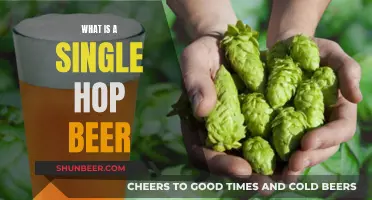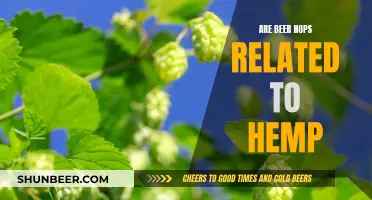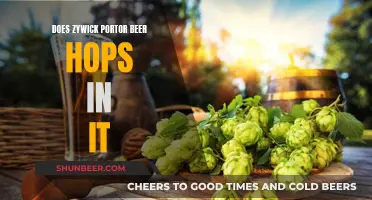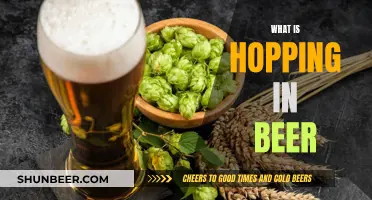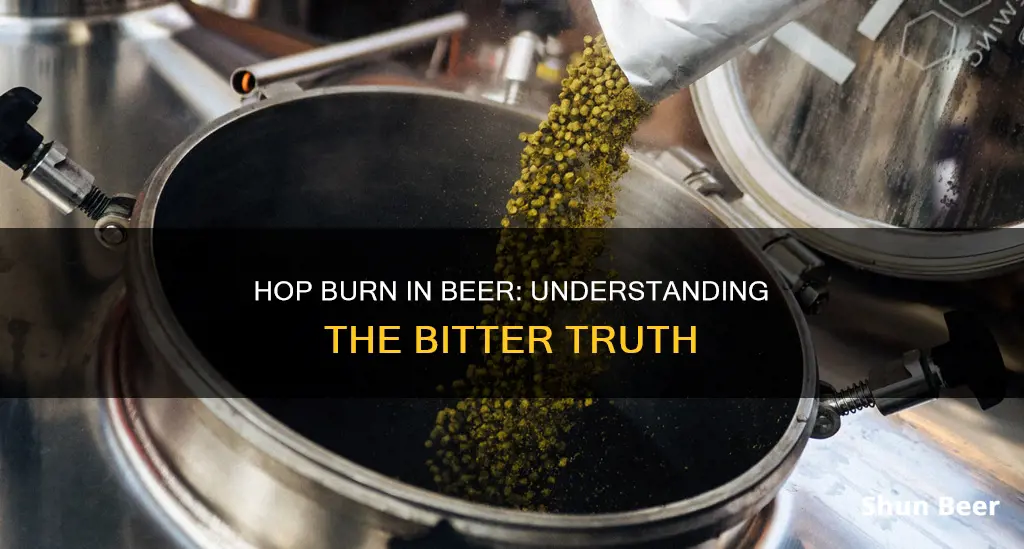
Hop burn, also known as hop bite, is a phenomenon in the beer world that has emerged in the last five years, alongside hazy IPAs. It is characterised by an extreme astringency, akin to sucking on a dry bag of black tea. Hop burn is perceived after swallowing beer, during the assessment of aftertaste. While there are no official studies on hop burn yet, it is believed to be caused by an overload of polyphenols found in the vegetative matter of hops. Hop burn can be mitigated by reducing the time that hops are in contact with the beer, as well as using hops with higher alpha acid percentages, which typically have lower polyphenol levels.
| Characteristics | Values |
|---|---|
| What is hop burn? | An off-flavour in beer, also known as "hop bite" |
| How does it occur? | When hops are added to the beer after primary fermentation or during the fermentation process |
| What does it taste like? | Extreme astringency, akin to sucking on a dry bag of black tea |
| What causes it? | Overloading on polyphenols found in the vegetative matter of hops |
| How to prevent it? | Shorten dry hop time, use fewer hops, use higher alpha acid hops, give the beer time to mature, use a clarifier, centrifugation |
What You'll Learn

Hop burn is an astringent bitter hop flavour
Hop burn, also known as hop bite, is a relatively new phenomenon in the world of beer, particularly in hazy IPAs. It is characterised by an extreme astringency, akin to sucking on a dry bag of black tea, and is often perceived after swallowing the beer. This unpleasant sensation is caused by the presence of polyphenols, which are found in the vegetative matter of hops. The longer the beer is in contact with the hops, the more polyphenols are extracted, resulting in a more astringent and rough mouthfeel.
While there have been no official studies or scientific papers published on hop burn specifically, it is believed to be a result of overloading on polyphenols. Chad Kennedy, a hop specialist at Brewers Supply Group (BSG), explains that hop burn is generally associated with the high polyphenol content found in the vegetative matter of hops. These polyphenols can cause a drying scratchiness at the back of the throat, which can be so harsh that it may trigger a gag reflex.
To minimise hop burn, brewers can use hops with higher levels of alpha acids, which typically have lower levels of polyphenols. Hops like the El Dorado variety, which can pack up to 17% alpha acid, are popular in hazy IPAs for this reason. Additionally, adding some bittering hops can help balance the flavour and reduce the hop-bite astringency.
Another way to minimise hop burn is to reduce the time the beer is in contact with the hops. Commercial brewers have found that extreme measures of hop separation, such as centrifugation, can help lessen hop burn. However, for homebrewers, simply cold-crashing the beer before racking can help create a more solid pile of sediment at the bottom of the fermenter. Allowing the beer to condition off of the hops before serving can also help to mellow out the burn.
While hop burn is an undesirable sensation for many beer drinkers, it is important to note that it is not a sign of contamination or improper brewing techniques. Rather, it is a result of the high polyphenol content in hops and can be minimised through careful selection of hop varieties and brewing processes.
Hop Boiling in Beer: Necessary or Not?
You may want to see also

It is caused by the overuse of hops
Hop burn, also known as hop bite, is a recently observed phenomenon in the world of beer, particularly in hazy IPAs. It is characterised by an extreme astringency, akin to sucking on a dry bag of black tea, and is often detected when assessing the aftertaste of a beer. While the exact cause of hop burn is yet to be scientifically proven, it is generally believed to be the result of the overuse of hops, specifically the overloading of polyphenols found in the vegetative matter of hops.
Polyphenols are compounds that contribute to the astringent and bitter characteristics of beer. When hops are added to the beer during the dry-hopping process, either after or during primary fermentation, the longer the hops remain in contact with the beer, the more polyphenols are extracted. This leads to an excessive amount of polyphenols in the beer, resulting in the harsh sensation of hop burn.
The relationship between hop usage and polyphenol extraction is further supported by the fact that hops with higher alpha acid (AA) percentages typically contain lower levels of polyphenols. Therefore, using hops with higher AA% can help reduce the occurrence of hop burn. Additionally, the time that the beer is in contact with the hops also plays a crucial role, as a shorter contact time allows for less extraction of polyphenols, thereby mitigating the risk of hop burn.
To summarise, hop burn is largely attributed to the overuse of hops, particularly those with higher polyphenol content. By understanding the relationship between hop usage, polyphenol extraction, and the resulting astringency, brewers can make informed decisions to prevent or minimise hop burn in their beers.
Hops and Cannabis: THC in Beer Explored
You may want to see also

It is a result of overloading on polyphenols
Hop burn is a recently observed phenomenon in the beer industry, particularly with the rise in popularity of hazy IPAs. It is characterised as an off-flavour, an unpleasant sensation, or an extreme astringency that is often perceived after swallowing the beer. While the exact cause of hop burn is yet to be confirmed through scientific studies, it is believed to be a result of overloading on polyphenols found in the vegetative matter of hops.
Chad Kennedy, a hop specialist at Brewers Supply Group (BSG), explains that the higher the alpha-acid content of the hop variety, the lower the polyphenol levels. Therefore, when hops with lower alpha-acid content are used in large quantities, it can result in an overload of polyphenols in the beer. This overload of polyphenols is what is thought to cause the sensation of hop burn.
The process of dry-hopping, which involves adding a large volume of hops to the fermenter post-fermentation, is a significant factor in the creation of hop burn. The sheer volume of hops used in modern IPAs, often double or triple the amount used in pre-hazy-era IPAs, increases the likelihood of hop burn occurring. Additionally, the length of time the beer is in contact with the vegetative hop matter also plays a role. The longer the contact time, the more polyphenols can be extracted, leading to increased astringency and a rough mouthfeel.
To put it simply, hop burn is a result of an excess of polyphenols in the beer, which creates an astringent and unpleasant sensation for the drinker. While the specific compounds and interactions that cause hop burn require further scientific investigation, the current understanding points towards the overload of polyphenols as the primary culprit.
The Success Story of Tropical Hop Beers
You may want to see also

It can be reduced by shortening dry hop times
Hop burn is a phenomenon in the world of beer, particularly in hazy IPAs, that has emerged in the last five years. It is an extreme astringency akin to sucking on a dry bag of black tea. Hop burn is caused by polyphenols found in the vegetative matter of hops. The longer the hops are in contact with the beer, the more polyphenols are extracted, resulting in a more astringent and rough mouthfeel. Therefore, shortening the dry hop time reduces the extraction of polyphenols and thus helps to mitigate hop burn.
Several studies have shown that concentrations of monoterpene alcohols and hydrocarbon hop fractions reach near-full extraction in beer after being on dry hops for just 24 hours. Sensory studies have also found that aroma intensity was the same for beers dry-hopped with pellets for six hours and four days. Shorter dry hop times were rated higher for fruity characteristics, while longer dry hop times were preferred for herbal notes. Agitating or stirring the hops can shorten the dry hop time needed for effective extraction, but it may also increase astringency and bitterness.
When it comes to reducing hop burn, it is recommended to dry hop with hops containing high levels of alpha acids, which tend to have lower levels of polyphenols. It is also suggested to use at least some bittering hops to balance the potential burn. Additionally, allowing the beer to condition off of the hops before serving can help to mellow out the burn.
For brewers, finding the optimal dry hop time is a balance between maximizing aroma extraction and minimizing the extraction of undesirable compounds like polyphenols. While longer dry hop times may result in more herbal notes, shorter dry hop times can enhance fruity characteristics. Ultimately, the ideal dry hop time may vary depending on the specific hops used and the desired flavour profile of the beer.
Dry Hopping in Primary: A Guide for Beer Brewers
You may want to see also

It can be prevented with the right technology
Hop burn is an extreme astringency in beer, akin to sucking on a dry bag of black tea. It is an off-flavour and an unpleasant sensation that is often perceived after swallowing beer. Hop burn is believed to be a result of overloading on polyphenols found in the vegetative matter of hops. The longer the vegetative hop matter stays in contact with the beer, the more polyphenols can be extracted, resulting in a more astringent and rough mouthfeel.
While there haven't been any official studies or scientific papers published on hop burn yet, it is generally believed to be caused by the presence of polyphenols in the beer. Alfa Laval, a company that provides innovative solutions to craft brewers, has developed several technologies to address the issue of hop burn.
One such technology is the Alfa Laval Alhop Dry Hopping System, which is designed for smaller volumes (50-200 kg pellets per dry-hopping run). This system uses cross-flow filtration technology to recirculate the beer over the hops until the desired aroma profile is reached. The built-in 100-micron stainless steel strainer prevents the hops from clogging the strainer and allows for a high recirculation flow rate over the beer tank. This system helps to reduce product losses and improve the efficiency of the dry-hopping process.
Another technology offered by Alfa Laval is the Iso-Mix External Drive (IMXD) Rotary Jet Mixer, which is better suited for larger volumes (200-5000 hl tanks). This system is integrated into the fermentation/maturation vessels and recirculates whole hop pellets through its nozzles, ensuring fast hop aroma extraction and full homogenization of the hop particles into the beer. The IMXD actively keeps the liquid homogenised, preventing the hops from floating or sedimenting. It also allows brewers to control the contact time between the hops and the beer, minimising product losses.
In addition to these technologies, Alfa Laval also offers the BREW series centrifuge, which can be used to remove coarse solids, such as yeast and dry hops, from the beer. This not only improves the clarity and quality of the beer but also helps to reduce dry hop creep by decreasing the number of cells in suspension. The centrifuge can also be used to replace clogged filters and control the amount of yeast retained in the beer.
By utilising these innovative technologies from Alfa Laval, craft brewers can effectively prevent hop burn and enhance the flavour and aroma of their beers without increasing bitterness. These solutions not only improve the quality of the beer but also help to streamline the brewing process and reduce product losses associated with dry hopping.
Hops to Beer: Acres of Fun and Flavor
You may want to see also
Frequently asked questions
Hop burn, or hop bite, is an unpleasant, astringent bitter hop flavour in beer. It is often perceived after swallowing beer and can be likened to sucking on a dry bag of black tea.
Hop burn is caused by the overloading of polyphenols found in the vegetative matter of hops. The longer the beer is in contact with the hops, the more polyphenols are extracted, resulting in a more astringent and rough mouthfeel.
Brewers can prevent hop burn by reducing the amount of hops used, shortening the dry hop time, and choosing hops with higher alpha acid (AA) percentages, which typically have lower levels of polyphenols.
Consumers can avoid hop burn by allowing their beer to age or condition for a few days after purchasing it. Freshly packaged beer may need some time to mellow out the burn.


